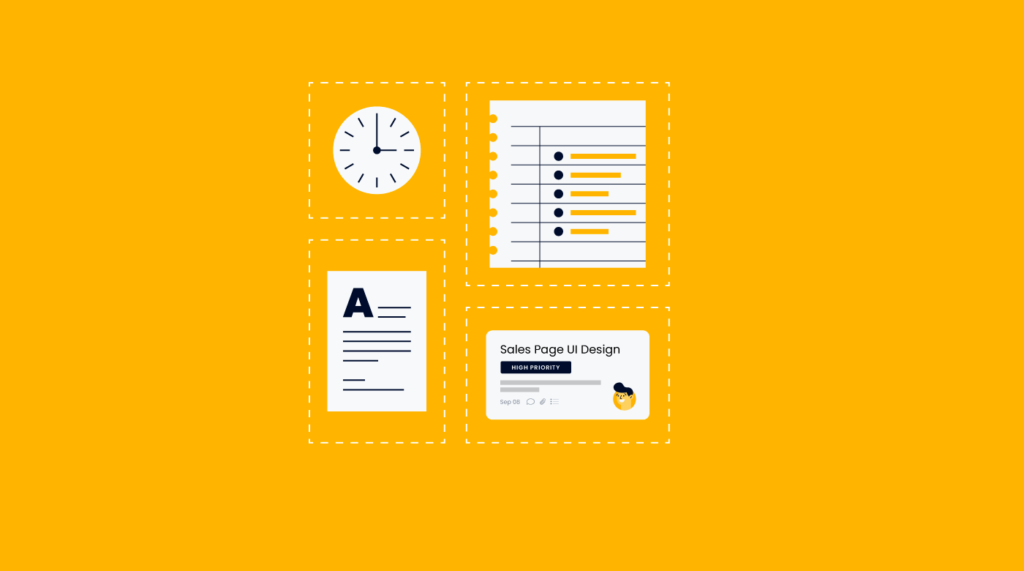Task management bridges the gap between the goals you documented in your project charter and what work needs to happen for your fledgling project to get off the ground.
It tends to be a glossed-over capability in project management because, while it sounds simple in theory, it can be trickier to execute in practice (although it’s made much simpler through the use of task management software rather than Excel spreadsheets).
What Is Task Management In Project Management?
Task management is a critical aspect of project management that involves:
- Identifying the tasks necessary to fulfill project goals: Break down project objectives into smaller, more manageable activities that can be assigned to individual team members. Ensure each task is clear, specific, and achievable, with a well-defined purpose and deadline. Unclear guidance may compromise timely, quality task completion.
- Assigning those tasks to team members: Consider the relative priority of each task or deliverable and assign it to the appropriate team member based on their skills and availability.
- Monitoring and tracking progress towards completion: This involves identifying potential roadblocks, removing impediments to execution, and making adjustments to the project timeline, as necessary.
The ultimate goal of task management is to ensure that each task is completed on time, to the required standard, and within budget.
Task Management vs Project Management
While task management and project management are related, they are not the same thing. Project management involves overseeing the entire project from inception to completion with a focus on key milestones, while task management focuses on the individual tasks and activities that make up the project.
Task management breaks down high-level project goals into smaller, more manageable tasks. Creating a project plan that outlines each task and its associated deadline (and inputting that information into your task management platform) makes it easier to track task progress and identify any potential roadblocks that may arise.
Why Is Task Management Important?
Task management offers several benefits, including:
- Increased efficiency and productivity. By having a clear understanding of what needs to be done and when, your team members can focus their efforts on completing their tasks rather than wasting time trying to figure out what they should be doing. This means faster turnaround times, increased output, and, ultimately, greater profitability.
- Improved communication and team collaboration. Through the process of breaking down projects into smaller, more manageable tasks, team members share ideas and insights with one another about their work. Gathering cross-functional perspectives leads to better decision-making and more innovative solutions to problems.
- Clearer understanding of project goals and objectives. When team members know what is expected of them and understand how their work impacts project and organizational goals, they are more likely to stay motivated and focused.
- Greater visibility into project progress. By tracking team tasks and monitoring progress, project managers can quickly identify potential issues and take corrective action before they become major problems. This can help to reduce the risk of missed deadlines and scope creep, which can be costly and damaging to a project's success.
How To Manage Tasks
Here’s a closer look at each step in the task management process:
Step 1: Identify Tasks
The first step in task management is to identify the set of tasks that need to be completed to achieve project goals.
To generate this list, brainstorm what steps you would need to take to execute against project goals and organize those tasks into categories. Consult the project plan, statement of work, and other foundational project documents to help you.
For example, if you’re building a website, you would probably include steps for design, development, and QA. You can categorize tasks based on priority, complexity, or the team or individual responsible for completing them.
Validate the task list with subject matter experts and other project team members and compare against prior projects that you or your organization has completed to be sure you don’t miss anything.
Once you have a list of tasks, you can further break them down into sub-tasks to make them more manageable. This will help you to identify any dependencies between tasks and ensure that you have a clear understanding of the work that must be accomplished.
Step 2: Schedule Tasks
Scheduling involves determining the start and due dates for each task and creating a timeline for the project. To do this, you can use a project management tool that allows you to create a Gantt chart or provides a timeline view.
When you are scheduling and prioritizing tasks, consider any task dependencies or recurring tasks. For example, if Task A needs to be completed before Task B can start, you need to ensure that Task A is scheduled before Task B. You also need to consider any constraints, such as internal or external deadlines, resource availability, or budget limitations.
Step 3: Assign Tasks
Effectively managing resources and assigning the project tasks to team members involves understanding each assignee’s skills and abilities and allocating tasks based on team workload and availability.
You can use a project management tool to assign tasks and track their progress. This will make it more interactive and help you to ensure that each team member knows what they need to do and when they need to do it. It will also help flag any potential bottlenecks or issues that may arise during the project.
Step 4: Track Progress
This involves monitoring the status of each task and making any necessary adjustments to the schedule. Task management software can help streamline how you monitor and report progress.
Effective task tracking requires regular communication with your team members. Building trusted relationships with your team gives you insights into any issues or challenges they may be facing when it comes to their project tasks. You can use this knowledge to help remove any blockers they may be facing and ensure tasks are accomplished more efficiently.
Step 5: Complete Tasks
The final step in task management is to ensure that each task is completed successfully. This involves reviewing the work to ensure that it meets the required quality standards and approving the task for completion.
To do this, you can use a checklist or a quality assurance process to ensure that each task meets the project requirements.
At the end of the project, don’t skip the opportunity to collect lessons learned. You can implement these findings to improve your task management process on future projects.
Task Management Best Practices
Best practices for task management include:
- Don’t work in a vacuum! Consult subject matter experts, your project sponsor, and other project managers to validate the activities that you’ve identified, what the work entails, their duration, and how you’ve allocated workload across the team. The better your planning, the smoother things will go in execution.
- Verify that completion of the tasks you’ve identified will help further your project objectives. If a task doesn’t help you do that, be wary of adding it to your project plan, as it may be a sign of scope creep.
- Schedule tasks realistically based on project constraints, like budget, timeline, and resource availability. If your stakeholders want a task completed by a certain date, but there’s just no way, don’t create a schedule that promises delivery by that deadline. Instead, meet with the team to formulate a workaround—whether that’s adjusting the deadline, adding resources, or reducing scope.
- Align team member motivations, capabilities, and availability with assigned tasks, where possible. This reduces the risk that you’ll fail to meet deadlines and/or quality thresholds.
- Document and communicate progress. Make sure you keep your stakeholders apprised of project progress and potential issues along the way, so you can course correct, as needed.
Common Pitfalls Of Task Management
While task management can lead to success, there are also common pitfalls that you should try to avoid:
- Micromanagement, which can lead to decreased motivation among team members. Instead, give team members the information they need to complete tasks but don’t be overly prescriptive about how they execute the work. Set up regular check-ins that you both agree upon at task outset to monitor interim progress
- Failure to prioritize tasks, which can result in missed deadlines
- Failure to provide sufficient detail when assigning tasks, which can lead to confusion and mistakes
- Overloading team members with too many tasks, which can result in burnout and decreased productivity. Instead, consider resource availability and workload when assigning tasks
- Failure to track progress, which can lead to missed deadlines and scope creep.
Benefits of Task Management Software
Task management software is an essential tool for large and small businesses, teams, or individuals that are looking to organize their tasks and projects efficiently. Benefits of task management systems include:
- Easier schedule management with calendar views
- Intuitive designs and templates that align with agile methodologies and sprint schedules
- User-friendly drag-and-drop functionality to reprioritize tasks on the fly
- Customizable task management features based on organizational needs and desired pricing (whether paid plans or free plans)
- Ability to adjust user permissions
- Integration with customer relationship management (CRM) systems.
Here’s a list of the 15 best task management software tools available on the market right now.
Different Types Of Task Management Tools
Task management tools can help you stay organized when it comes to work management, increase productivity, and foster teamwork. Examples include:
- To do lists. To do lists are an essential tool for managing tasks and keeping yourself organized. Ranging from sophisticated mobile apps like Todoist to analog lists, there are a variety of ways to keep track of tasks, master your workload, and improve efficiency.
- Kanban boards. Kanban boards are a type of task management tool that provides teams with a visual system to manage projects, workflows, and communication. They consist of columns representing different stages of a team’s workflow and cards representing individual tasks. As cards move through the workflow, teams use the board to spot inefficiencies in task progress, limit work in progress, and enhance collaboration.
- Project management software. Project management software (which is slightly different from task management software) helps plan, organize, and manage projects. Tools typically include features such as task lists, calendars, and project timelines. Some popular project management software includes Asana, Wrike, monday.com, Clickup, and Trello.
- Task management software. Task management solutions help manage individual tasks and to-do lists. It typically includes features such as task lists, notifications, reminders, and progress tracking. Some popular task management apps include Todoist, Wunderlist, and Any.do, which are available for iOS and Android devices.
- Collaboration tools. Collaboration tools are designed to help teams work together more effectively. These tools typically include features such as task lists, project timelines, and communication tools, and are particularly useful for geographically dispersed or remote teams. Some popular collaboration tools include Trello, Asana, and Slack.
- Time tracking software and integrations. Time tracking software tracks how much time you spend on different tasks, and is useful for individuals or teams who need to invoice clients based on hours logged or automate their tracking of project expenses. It can also help you identify areas where you may be spending too much time (read: budget) and make adjustments to your workflow.
What’s Next?
Looking for more task management tips and best practices? Sign up for DPM membership and join the conversation in Slack with 100s of other digital project managers.


